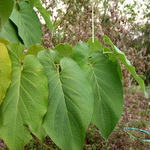| Common Name: |
Yerba Santa Acuyo |
| Other Names: |
Hoja Santa, Makulan |
| Botanical Name: |
Piper auritum |
| Genus: |
Piper |
| Family: |
Piperaceae |
| Native Location: |
Mexico |
| Cultivation: |
Rich, well-drained soil in light shade and high humidity (P. longum, P. nigrum). Deep, rich soil, including heavy clay, ample moisture and shade (P. betle, P. cubeba). P. auritum thrives in full sun. Well-drained, stony soil, with ample water and humidity, in sun (P. methysticum). Plants are usually grown on frames. Remove weak of congested stems in late winter or early spring before new growth begins. For optimum fruiting (P. nigrum), cut back young plants to 30cm (12in) several times a year to stimulate growth of shoots, retaining the ten strongest, and tying in at each node. Mature vines are pruned regularly to 4m (12ft). Susceptible to fungal root rot, pepper weevil, and pepper flea beetle. |
| Propagation: |
By seed sown at 20-24°C (66-75°F); by semi-ripe cuttings in summer. |
| Harvest: |
Leaves are picked as required (P. auritum), blanched in the dark, often pressed together, and dried for extracts or to use whole (P. betel). Roots are lifted as required, usually from plants about 2m (6ft) tall, and used fresh, or dried for use in decoctions, liquid extracts, powders, and tablets (P. methysticum). Fruits are picked unripe and distilled for oleo-resin and oil, or dried for use in liquid extracts, powders and tinctures (P. cubeba). Fruit clusters are picked unripe and dried for use whole, ground or in decoctions (P. longum). Fruits of P. nigrum are picked unripe and used fresh, pickled (green peppercorns), and dried (green and black peppercorns); or ripe, and retted for eight days before drying (white peppercorns); black peppercorns are ground or decocted for medicinal use. |
| Height: |
4m (12ft) |
| Width: |
4m (12ft) |
| Hardiness: |
Min. 10°C (50°F) |
| Parts Used: |
Leaves |
| Properties: |
An aromatic herb with a sarsaparilla-like flavor. It contains saffrole, and aporphine-type alkaloids whose effects are unknown. |
| Medicinal Uses: |
Externally as a poultice to relieve headaches. |
| Culinary Uses: |
Leaves are used in C America as a flavoring in many different dishes, including tamales. |
| Bibliography: |
Encyclopedia of Herbs by Deni BrownCopyright © 1995, 2001 Dorling Kindersley Limited. pp. 319-320 |

